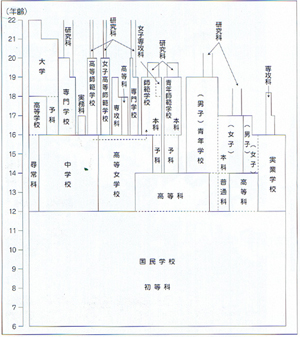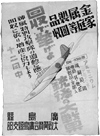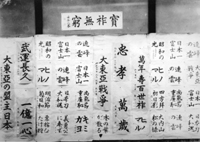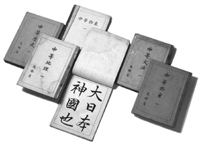 |
| Schools Stained the Color of War |
| When the Sino-Japanese War broke out in 1937, the color of war suddenly stained the whole of Japan. The people were ordered to cooperate with the war, which also cast its dark shadow over school education. Major school events like field trips disappeared in favor of militaristic training, such as martial arts and marching. Starting in 1943, to compensate for shortfalls in combat strength and labor, the school year was shortened and graduation moved up for all students in secondary school and upwards. Except for those on the science and engineering track, the academic exemption for college students ended. College students were enlisted and sent to the front. With the war raging furiously in 1944, "national school" students between the third and sixth grades were separated from their families and evacuated to the city outskirts or the countryside to spare them from air raids. Simultaneously, all class work was suspended for students in the upper level of national school and older. They were mobilized to labor at munitions plants and the like year round. |
 |
1/The Education System in 1944
In 1941, elementary schools were renamed "national schools." National schools were divided into lower-level and upper-level grades. The lower level comprised grades 1 to 6, while the higher level comprised grades 7 and 8 (12- to 14-year old students). Secondary schools (a category that included junior high schools, girls' high schools, and vocational schools) were shortened from five-year programs to four-year programs in 1943. Students attended from the age of 12 to 16. |
||
 |
2/All
for war - Poster requesting cooperation with the Metal Confiscation
Program
|
||
|
|
 5/Students at Hiroshima Prefectural Industrial School undergoing military training
5/Students at Hiroshima Prefectural Industrial School undergoing military trainingCourtesy of Hiroshima Prefectural Technical High School Alumni Association |
||
Donated by Chieko Okamoto These nationally designated textbooks were used by students at Hiroshima Prefectural Industrial School. In 1943, it was decided that the existing textbook approval system would be dropped, and a single set of nationally designated books would be used at all secondary schools. The content was heavily influenced by the war climate. | |||
| Mobilized Students -The Lost Tomorrows of the Students- Introduction Schools Stained the Color of War The Start of Student Mobilization Building Demolition Amplified the Tragedy The Suffering of Mobilized Students Looking for Children Reopening in the Burnt Ruins Monuments to the Students Return to TOP |

